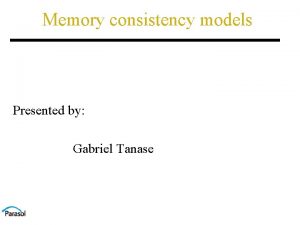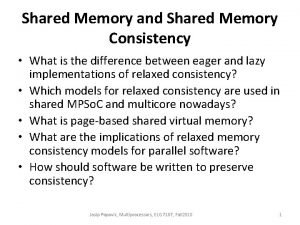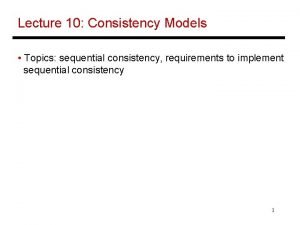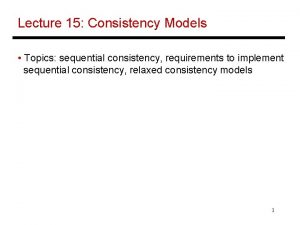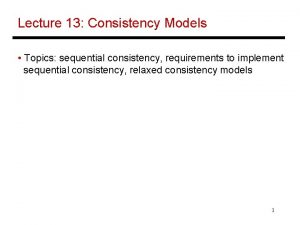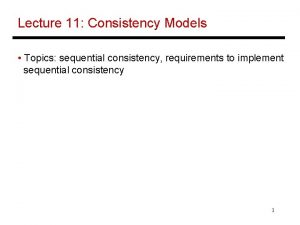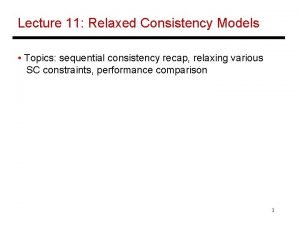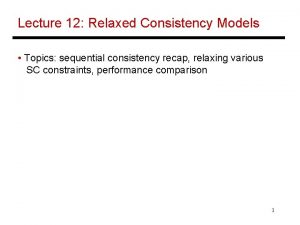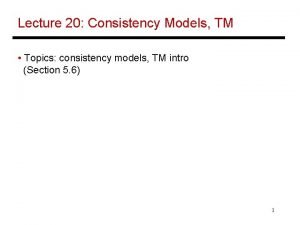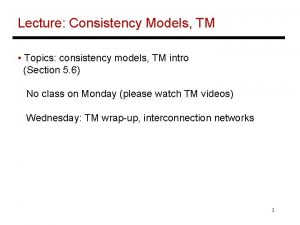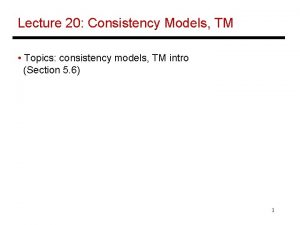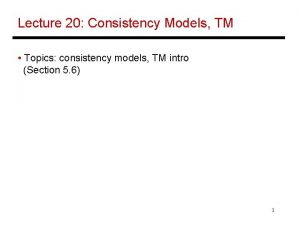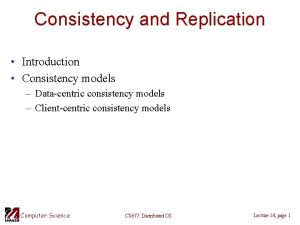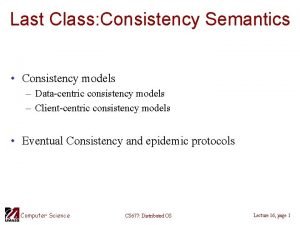Lecture 7 Consistency Models Topics sequential consistency requirements


















- Slides: 18

Lecture 7: Consistency Models • Topics: sequential consistency, requirements to implement sequential consistency, relaxed consistency models 1

Coherence Vs. Consistency • Recall that coherence guarantees (i) that a write will eventually be seen by other processors, and (ii) write serialization (all processors see writes to the same location in the same order) • The consistency model defines the ordering of writes and reads to different memory locations – the hardware guarantees a certain consistency model and the programmer attempts to write correct programs with those assumptions 2

Example Programs Initially, A = B = 0 P 1 A=1 if (B == 0) critical section P 2 B=1 if (A == 0) critical section P 1 Data = 2000 Head = 1 P 2 while (Head == 0) {} … = Data Initially, A = B = 0 P 1 A=1 P 2 P 3 if (A == 1) B=1 if (B == 1) register = A 3

Sequential Consistency P 1 Instr-a Instr-b Instr-c Instr-d … P 2 Instr-A Instr-B Instr-C Instr-D … We assume: • Within a program, program order is preserved • Each instruction executes atomically • Instructions from different threads can be interleaved arbitrarily Valid executions: ab. Ac. BCDde. E… or ABCDEFab. Gc… or abc. Ad. Be… or a. Ab. Bc. Cd. De. E… or …. . 4

Sequential Consistency • Programmers assume SC; makes it much easier to reason about program behavior • Hardware innovations can disrupt the SC model • For example, if we assume write buffers, or out-of-order execution, or if we drop ACKS in the coherence protocol, the previous programs yield unexpected outputs 5

Consistency Example - I • Consider a multiprocessor with bus-based snooping cache coherence and a write buffer between CPU and cache Initially A = B = 0 P 1 P 2 A 1 B 1 … … if (B == 0) if (A == 0) Crit. Section The programmer expected the above code to implement a lock – because of write buffering, both processors can enter the critical section The consistency model lets the programmer know what assumptions 6 they can make about the hardware’s reordering capabilities

Consistency Example - 2 P 1 Data = 2000 Head = 1 P 2 while (Head == 0) { } … = Data Sequential consistency requires program order -- the write to Data has to complete before the write to Head can begin -- the read of Head has to complete before the read of Data can begin 7

Consistency Example - 3 Initially, A = B = 0 P 1 A=1 P 2 P 3 if (A == 1) B=1 if (B == 1) register = A Sequential consistency can be had if a process makes sure that everyone has seen an update before that value is read – else, write atomicity is violated 8

Sequential Consistency • A multiprocessor is sequentially consistent if the result of the execution is achieveable by maintaining program order within a processor and interleaving accesses by different processors in an arbitrary fashion • The multiprocessors in the previous examples are not sequentially consistent • Can implement sequential consistency by requiring the following: program order, write serialization, everyone has seen an update before a value is read – very intuitive for the programmer, but extremely slow 9

Relaxed Consistency Models • We want an intuitive programming model (such as sequential consistency) and we want high performance • We care about data races and re-ordering constraints for some parts of the program and not for others – hence, we will relax some of the constraints for sequential consistency for most of the program, but enforce them for specific portions of the code • Fence instructions are special instructions that require all previous memory accesses to complete before proceeding (sequential consistency) 10

Fences P 1 { P 2 { Region of code with no races } } Fence Acquire_lock Fence { { Racy code } Fence Release_lock Fence 11

Other Performance Optimizations • Program order is a major constraint – the following try to get around this constraint without violating seq. consistency Ø if a write has been stalled, prefetch the block in exclusive state to reduce traffic when the write happens Ø allow out-of-order reads with the facility to rollback if the ROB detects a violation (detected by re-executing the read later) 12

Potential Relaxations • Program Order: (all refer to different memory locations) Ø Write to Read program order Ø Write to Write program order Ø Read to Read and Read to Write program orders • Write Atomicity: (refers to same memory location) Ø Read others’ write early • Write Atomicity and Program Order: Ø Read own write early 13

Relaxations Relaxation W R Order IBM 370 X TSO X PC X SC W W R RW Rd others’ Wr Order early Rd own Wr early X X Ø IBM 370: a read can complete before an earlier write to a different address, but a read cannot return the value of a write unless all processors have seen the write Ø SPARC V 8 Total Store Ordering (TSO): a read can complete before an earlier write to a different address, but a read cannot return the value of a write by another processor unless all processors have seen the write (it returns the value of own write before others see it) Ø Processor Consistency (PC): a read can complete before an earlier write (by any processor to any memory location) has been made visible to all 14

Performance Comparison • Taken from Gharachorloo, Gupta, Hennessy, ASPLOS’ 91 • Studies three benchmark programs and three different architectures: § MP 3 D: 3 -D particle simulator § LU: LU-decomposition for dense matrices § PTHOR: logic simulator Ø LFC: aggressive; lockup-free caches, write buffer with bypassing Ø RDBYP: only write buffer with bypassing Ø BASIC: no write buffer, no lockup-free caches 15

Performance Comparison 16

Summary • Sequential Consistency restricts performance (even more when memory and network latencies increase relative to processor speeds) • Relaxed memory models relax different combinations of the five constraints for SC • Most commercial systems are not sequentially consistent and rely on the programmer to insert appropriate fence instructions to provide the illusion of SC 17

Title • Bullet 18
 Processor consistency model
Processor consistency model Bitcoin
Bitcoin Sequential sampling models
Sequential sampling models Distributed shared memory architecture tutorialspoint
Distributed shared memory architecture tutorialspoint Monotonic read consistency
Monotonic read consistency Memory consistency models in distributed systems
Memory consistency models in distributed systems Client-centric consistency models
Client-centric consistency models 01:640:244 lecture notes - lecture 15: plat, idah, farad
01:640:244 lecture notes - lecture 15: plat, idah, farad Difference between model and semi modal
Difference between model and semi modal Visual models for software requirements
Visual models for software requirements Sequential intercept model definition
Sequential intercept model definition What is linear data structure
What is linear data structure Downheap vs upheap
Downheap vs upheap Sequential search java
Sequential search java Plot sequence diagram
Plot sequence diagram Cross sequential study
Cross sequential study Event trapping menus
Event trapping menus Cs 247
Cs 247 Batch sequential architecture example
Batch sequential architecture example
